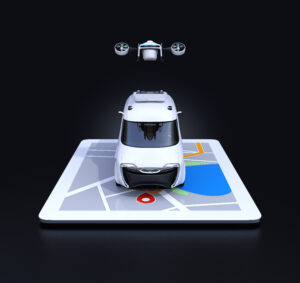How to build food ordering and delivery apps like UberEats or Postmates?
In today’s world, the consumer’s want for convenience and speed has boosted the need to build on-demand apps. Business owners & entrepreneurs are rapidly adapting to the idea of taking their food ordering and delivery business online via mobile apps supported by delivery tracking software. According to a Morgan Stanley report, the total market share of digital food delivery would increase to 11% by 2022 in today’s comparison to 6%. The on-demand food delivery apps of recent times like UberEats, Deliveroo, Postmates, Zomato, Swiggy and quite a few others are a great example of the traction that this segment commands globally. Meanwhile, this success has lured many businesses and entrepreneurs to make lucrative investments in creating food delivery apps.
How does this on-demand food delivery app work?
On-demand delivery apps have 3 stakeholders-
1. Customers- They generate the demand by placing orders to restaurants via the food delivery apps.
2. Restaurants- Aggregation of restaurants or having a single storefront, depending on your business model, forms the supply side.
3. Delivery Personnel- Integration of demand and supply side by providing logistics support is done by the delivery agents.

The key features of a food delivery system are-
1. Catalogue Management
Food menu, prices and special offers are displayed to customers on intuitive customer apps. They provide customers to view a variety of options and order their favorite burger on the go. At the same time, restaurants or merchants can also modify their listings form their merchant app and web panel. Another interactive and customer-centric feature is Custom Orders. This enables home delivery of anything from food, flowers, medicines, grocery, packages etc. from a single platform, just like Postmates. This creates an easy and reliable system for product listings and management of orders and prices.
2. Payment Integrations
Ensuring successful payments via multiple channels form a critical part of a delightful online ordering experience for customers. By integrating multiple payment gateways on your iOS and Android customer mobile apps, you give your customers the freedom to pay via wallets, cards or cash securely.
3. Delivery Management
Many restaurants these days prefer to integrate their order management system with their food delivery and tracking apps. These driver-centric apps provide route optimization, real-time tracking and order fulfilment status. Another feature gaining popularity is the electronic proof of delivery via image capture, digital signature, barcode scanning etc. Aligning with a complete delivery management suite ensures timely multiple delivery management, increases productivity of delivery agents and reduces the overall operational costs of the food delivery business.
4. Multi-language Support
Due to the increasing popularity of apps like UberEats, Deliveroo, Postmates, Zomato and Swiggy, many business owners across the world are eager to take their food delivery businesses online. Having mobile apps that support the regional language of the target market can significantly increase customer engagement and supply side responsiveness.
5. Marketing & Customer Support
Built-in marketing tools in customer apps allow business owners to pitch in custom discounts and referral offers to their customers. In-app chat support enables customers to get their queries solved in real-time. This not only increases user stickiness but also helps business owners gain traction and growth.
6. Performance Management
With a complete order management and delivery tracking system, business owners can manage everything at one place from their admin dashboard. Access controlled managerial roles can also be created to monitor medium to large scale businesses. Through data analytics, business owners can gain insights on top trends and identify operational bottlenecks. Monitoring performance and automating operations from a single panel gives the business owners a competitive edge by ensuring data coherency and transparency.
After analyzing the target market and assembling the feature requirements for the food delivery apps, business owners still face a variety of challenges spanning from creating a unique value proposition for their customers to finding the best app developers. Some of the challenges might be:
1. Getting the right product-market fit
We have thrown some light on the key stakeholders of a food delivery app and its key features. Before the app development process begins, business owners should gather the MVP requirements according to the target audience. For instance, UberEats’ USP is that it delivers a variety of delicacies from a variety of restaurants. Postmates, on the other hand, has established its USP in not restricting themselves to just food and delivering just about anything.
2. Onboarding the restaurant owners
Business owners should ensure that the business owners are smoothly on-boarded onto the food delivery management platforms to maintain stickiness. It will not only maintain a good order fulfilment rate but will also attract more customers who look for a variety of cuisines on a single platform. Initiating partnerships with restaurants, setting commissions and maintaining long-term relationships will help business owners to boost supply.
3. Gaining customer traction on app
Developing a good marketing strategy by covering all customer touch-points and monitoring ROI, LTV and CAC values will pave way for the right burn to growth ratio for your food delivery business. Creating custom discount offers, referral code benefits and displaying pop-ups during peak hours to customers will help business owners strike the right chord with their target audience.
4. Creating a smooth UI/UX
Planning a smooth and meaningful journey for the customers and drivers on the apps is imperative in the adoption of the food delivery apps. Right from the point at which customers download your app, they should be able to navigate, select, order, pay, track, communicate with great ease. Add on features to make the user journey more intuitive and convenient must be updated constantly to delight and retain them.
5. Selecting the best app developers
Many factors come into play in the development of on-demand apps. Resources available in terms of technology, developers, money and time determine if the app is developed in-house or outsourced to trusted app builders. Jugnoo Deliveries is one such on-demand app developer. They provide complete ordering and delivery app solutions such as UberEats and Postmates for aspiring on-demand businesses.
Get in touch to start your UberEats/Postmates like business today.





